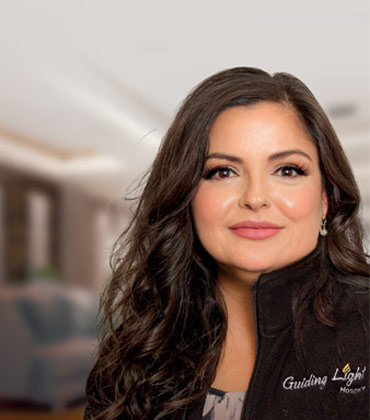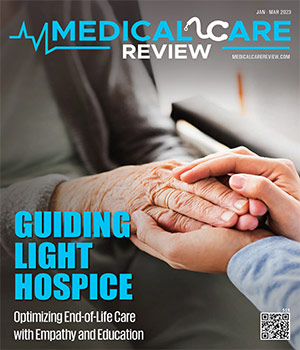- Home
- Guiding Light Hospice
End-of-life care is a complex undertaking, but if executed correctly, it can make a significant difference in the quality of life of a terminally ill patient and their loved ones left behind.
Misconceptions around end-of-life priorities deprive patients and families of sufficient care. Patients, in their last days, want to spend their time with dignity in their homes, surrounded by loved ones. Too many times, healthcare professionals fail to recognize early on the need for hospice care, leaving the patient overwhelmed and with no support in the home.
Guiding Light Hospice offers the holistic hospice care patients desire in their last days.
“We have been taught to live well, but we have not been taught to die well,” says Monica Narváez Trust, CEO of Guiding Light Hospice. “Our mission is to educate the community on how we work with families in tailoring our services around the patient’s needs. Our goal is to provide peace of mind to family members that their loved one is given everything needed to ensure their comfort.”

“In many cases, we find a lack of understanding in what hospice care is in terms of the care provided,” adds Trust. “Many times, families will tell us how they wished they knew of our services earlier, which is why we continue reaching out to the community on hospice care’s benefits to remove some of the associated stigmas. We want patients to get access to hospice care sooner, not when they have only three days left.”
Raising Awareness Around Hospice Care
Hospice is one of the most underutilized types of care in the U.S.
Going by the numbers, in San Antonio—the seventh largest city in the U.S.—more than 2,000 eligible people did not get access to hospice in the third quarter of 2022.
We believe the final days of life should be just as impactful as the early ones, and there is no reason why patients shouldn’t get to experience the same peace, love, and comfort
It can also make decisions based on what’s best for the patient, rather than following a conventional, rigid system of care. Putting patients first is where Guiding Light Hospice excels.
At the same time, it works on dispelling the many myths surrounding hospice care, including beliefs that ‘hospice is for those whose death is just hours or days away’ or that ‘your own doctor can’t treat you if you’re in hospice.’
Guiding Light Hospice is committed to educating families and the healthcare community at large, which includes relevant healthcare professionals and clinicians. It encourages them to talk about this underutilized level of care and the services provided, and in turn, facilitates the more empathetic conversations needed for hospice patients.
Guiding Light for The Patients and Their Families
Its integrated approach to hospice care delivers physical, emotional, and spiritual support to patients and their families, ensuring the end-of-life transition is peaceful and meaningful. Whether in a hospital or a patient’s home, Guiding Light Hospice is always ready to care for patients where the family chooses.
“We listen to the patient and their family members and make it clear we are not giving up on them,” says Trust. “We believe the final days of life should be just as impactful as the early ones, and there is no reason why patients shouldn’t get to experience the same peace, love, and comfort.”
Constant collaboration between the team, physicians, and family ensures patients are never neglected.
The collaborators meet every 14 days to discuss the patient’s needs and requirements. This constant communication forms the basis of holistic and continuous care to improve quality of life.
A family’s primary caregivers are also supported to ensure they don’t experience caregiver burnout. The team makes sure they are not overwhelmed by always being ready to take over whenever they feel exhausted. All these aspects combine to guarantee the patient is at the center of care and that their wishes are respected.
Although Guiding Light is not a 24/7 care, but its teams are available 24/7 to address the needs of its clients. Patients and families receive the help they need even after work hours, on weekends, and on holidays. Guiding Light does not have a call service. The patients directly call the care team. When a patient requests help, the person who responds is always someone they know on a first-name basis. This personal level of engagement is what patients need to feel safe and cared for.
Passionate About Creating Good Memories
Providing compassionate hospice care starts by getting to know the patient and their family’s principles. The process begins the moment a referral is made by the patient’s physician, family member, or the patient. Everyone’s needs are evaluated, and a care plan is developed.
The beauty of Guiding Light’s care is it encompasses a team of physicians, registered nurses, licensed vocational nurses, certified nursing assistants, social workers, and spiritual support. The team ensures holistic care is provided according to the patient’s wishes.
Strong Spiritual Support is another important is crucial aspect. Whatever the patients and family’s belief or cultural tradition, they can find the support and comfort needed by the team of spiritual counselors.
Caring does not stop when the patient is gone. Longer length of stay is important for ensuring better outcomes for the loved ones left behind. After the loss of a close one, the family might experience symptoms of severe depressive disorder. Research shows that the risk of depression decreases proportionally with the length of hospice care, where up to three days of hospice care shows a risk of 24.1 percent. But if the duration is around two weeks, the risk can dip to just three percent.
“For this reason, family members count on us for our services even after end-of-life,” says Trust. “We offer bereavement assistance for 13 months, which includes preparing the family for what to expect next, supporting delicate family dynamics and providing resources, and helping explain the loss of a loved one to children in age-appropriate ways. This is vital for the wellbeing of loved ones left behind after death.”
A Chapter From The Founder’s Hospice Care Experience
Trust recalls the winter of 2020, when her mother, Rosalinda, was suffering from stage-four gallbladder cancer and was in hospice care. Even while leading the hospice care team, Trust was not immune to emotional turmoil as her mother’s condition declined. She also needed the support of the hospice care team.
“They had to explain to me that it was time to take her home,” says Trust. “We brought her home in an ambulance. My team arrived, assessed her condition, and got her pain under control.”
The hospice care team played a vital role in supporting Trust and her family when attending to Rosalinda’s medical needs. The team ensured she was treated in the most comfortable manner. A nurse was placed at her bedside in adherence to strict regulatory guidelines to avert caregiver burnout. Social workers guided Trust’s father and Rosalinda’s grandchildren, who needed a different approach to processing the situation. In addition, a physician was very involved and led the team in providing end-of-life medical care.
-
We want patients to get access to hospice care sooner, not when they have only three days left
“Our days together, in the end, make me glad I started Guiding Light Hospice,” says Trust. “It’s been two years since her passing, and I have visited many of the places she wanted us to visit together. My last memories with her are good ones.”
Almost 99 percent of patients would rather spend their last days at home. It is important for families to understand their loved one’s point of view, and find closure at their own pace. Families have time to convey their gratitude and emotions in a private and homey environment. They can show their love and make the entire family feel content.
Raising Awareness and Pushing Hospice Care to The Mainstream
Guiding Light will conduct a Hospice and Palliative Care Walk soon to honor families providing care for their loved ones. It is trying to get more reimbursements for families and agencies to encourage timely hospice care delivery for patients in need. Trust believes that along with living well, patients should have the opportunity to die well.
In recognition of its quality care, Guiding Light recently received a deficient free reaccreditation by CHAP. It has garnered overall 100 percent satisfaction ratings by the patients and families that it serves. It seeks to keep the bar higher moving forward.
Trust’s recruitment process plays into this. When she interviews potential employees, she focuses on assessing their level of compassion. Either one is born with it or not. Every team member should lead with compassion, and this is what she looks for when building her team.
Guiding Light Hospice is committed to being a leader and working diligently in removing the stigma around it, while providing compassionate and best-in-class services that elevate the quality of life for patients, respect their individuality, and give family members peace of mind.
Thank you for Subscribing to Medical Care Review Weekly Brief





